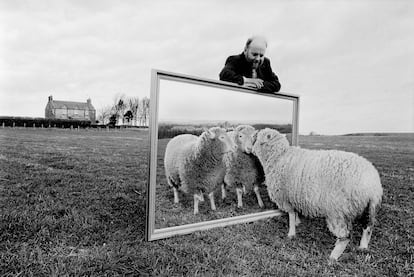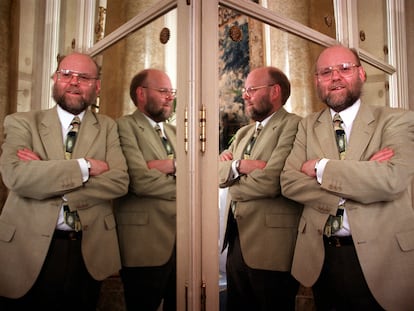Did the father of Dolly the Sheep deserve the Nobel Prize?
Ian Wilmut, who died on Monday at age 79, was an honest scientist who found himself in the eye of the storm of the cloning controversy

I interviewed the late Ian Wilmut 20 years ago, shortly after his amazing creature, Dolly the Sheep, the world’s first cloned mammal, had died. The death of the happily oblivious animal had aroused a wave of rejection for cloning and, in broader terms, for all human intervention in nature. The poor Scottish sheep, according to critics, had short chromosomes, was in poor health and had died prematurely, thus paying the price of the insolence shown by Wilmut and its other creators.
Shortly before, however, this newspaper had learned from a Spanish veterinarian that Dolly had not died from any genetic abnormality, but due to a lung cancer caused by a virus that is very common in sheep throughout Europe. Wilmut had not said a word about this global controversy, so I asked him about it, and he replied: “Yes, we think that is the correct explanation. We wanted to announce it on the day of [Dolly’s] death but the vet dissuaded us. He wanted to see the autopsy first.”
You need to have steel nerves to react like that. Here you are, the creator of the first mammal cloned from an adult cell, your animal dies of the same causes as any old sheep, you find yourself in the eye of a storm against cloning, half the world is trying to ruin your scientific reputation and, suddenly, the vet tells you to keep quiet and you remain silent like an intern. Brilliant.
But that was Wilmut all over: an honest scientist who was always willing to question his own conclusions and submit his work to the demanding review of his peers. His attitude was the same during what has surely been the greatest fraud in the history of biology. Just one year after Dolly’s death, the South Korean veterinarian Hwang Woo-Suk published an article in the journal Science announcing that he had created human embryonic stem cells by cloning. A year and a half later, it emerged that he had fabricated the entire research. Hwang was an expert at cloning — he created Snoopy, the first cloned dog — and he knew how to manipulate his data to confuse (almost) any expert. By the time he was caught, he had persuaded Western scientists to collaborate with him in ushering in a new era of biomedicine. Many heads rolled, and many others fell silent.
That was a disaster, and it dragged all cloning research into a thorough, almost excessively meticulous process of review. Starting, naturally, with Wilmut, the father of the aborted revolution. The cloning of Dolly was not an example of experimental planning. The starting material was not a live sheep, but an udder that had been frozen for some time. The photo that all the newspapers in the world would have carried on their front pages — the mother and her clone bleating as one — was therefore not possible. Skepticism grew after Hwang’s fraud.
But Wilmut, at least, had taken the precaution of preserving some frozen pieces of the udder that he had used to create Dolly. That was enough for independent scientists to verify that, unlike Hwang’s human embryos, Dolly was a true clone.
Should Wilmut have received the Nobel Prize? In my opinion, yes he should. But ask people at the cafeteria of any medical school and you will come out with a dizzying range of opinions. The Nobel Prize for cloning was awarded in 2012, nine years after Dolly’s death, to the British scientist John Gurdon and the Japanese researcher Shinya Yamanaka. They both deserved it. Gurdon had cloned the first animal, a frog, 20 years before Dolly was born, and Yamanaka had just discovered a way to “turn back the clock” of ordinary skin cells to turn them into stem cells, thus avoiding the controversial use of human embryos for the same purpose. The Swedish Academy suffers from a well-known allergy to public controversy. Wilmut never looked for a fight, but he found one anyway. May the Earth be kind to him.
Sign up for our weekly newsletter to get more English-language news coverage from EL PAÍS USA Edition
Tu suscripción se está usando en otro dispositivo
¿Quieres añadir otro usuario a tu suscripción?
Si continúas leyendo en este dispositivo, no se podrá leer en el otro.
FlechaTu suscripción se está usando en otro dispositivo y solo puedes acceder a EL PAÍS desde un dispositivo a la vez.
Si quieres compartir tu cuenta, cambia tu suscripción a la modalidad Premium, así podrás añadir otro usuario. Cada uno accederá con su propia cuenta de email, lo que os permitirá personalizar vuestra experiencia en EL PAÍS.
¿Tienes una suscripción de empresa? Accede aquí para contratar más cuentas.
En el caso de no saber quién está usando tu cuenta, te recomendamos cambiar tu contraseña aquí.
Si decides continuar compartiendo tu cuenta, este mensaje se mostrará en tu dispositivo y en el de la otra persona que está usando tu cuenta de forma indefinida, afectando a tu experiencia de lectura. Puedes consultar aquí los términos y condiciones de la suscripción digital.
More information
Archived In
Últimas noticias
Most viewed
- Sinaloa Cartel war is taking its toll on Los Chapitos
- Oona Chaplin: ‘I told James Cameron that I was living in a treehouse and starting a permaculture project with a friend’
- Reinhard Genzel, Nobel laureate in physics: ‘One-minute videos will never give you the truth’
- Why the price of coffee has skyrocketed: from Brazilian plantations to specialty coffee houses
- Silver prices are going crazy: This is what’s fueling the rally











































